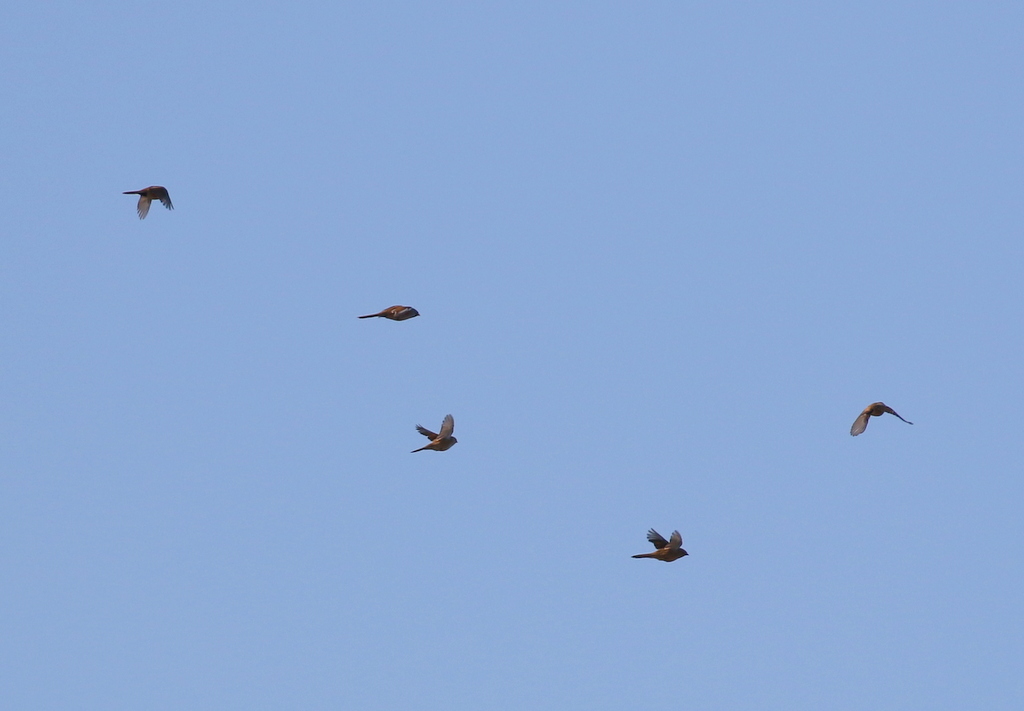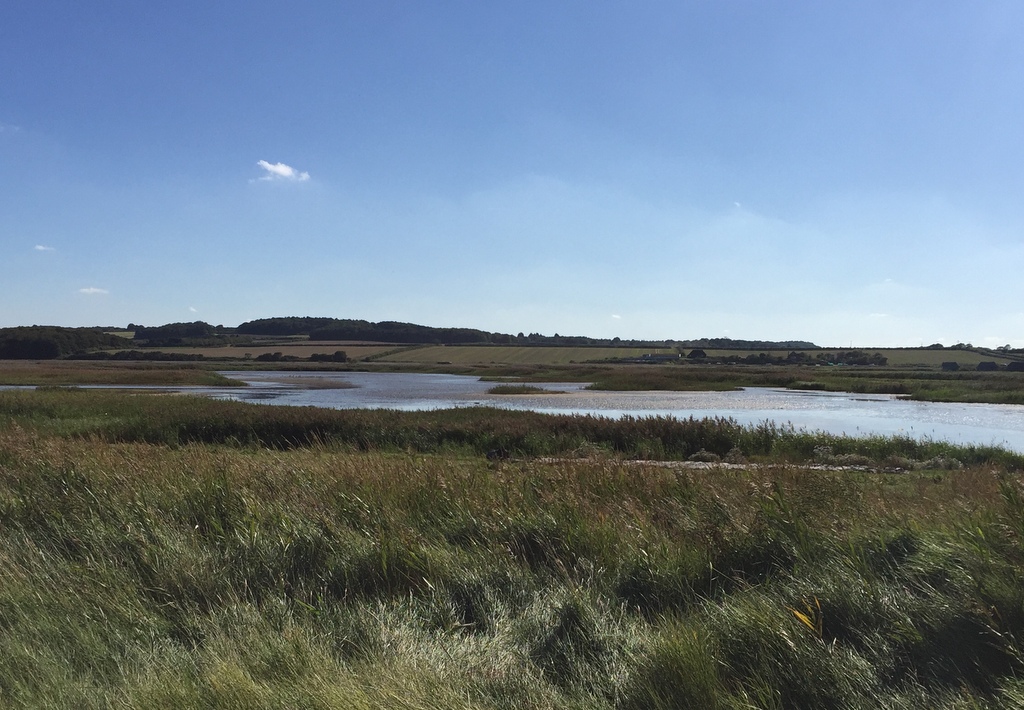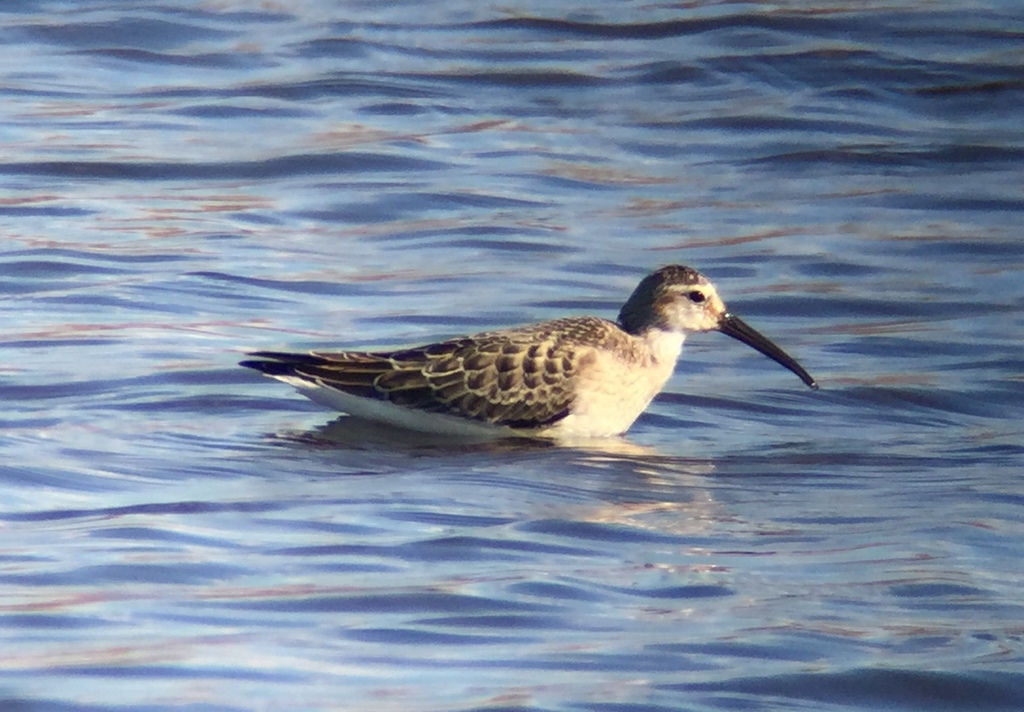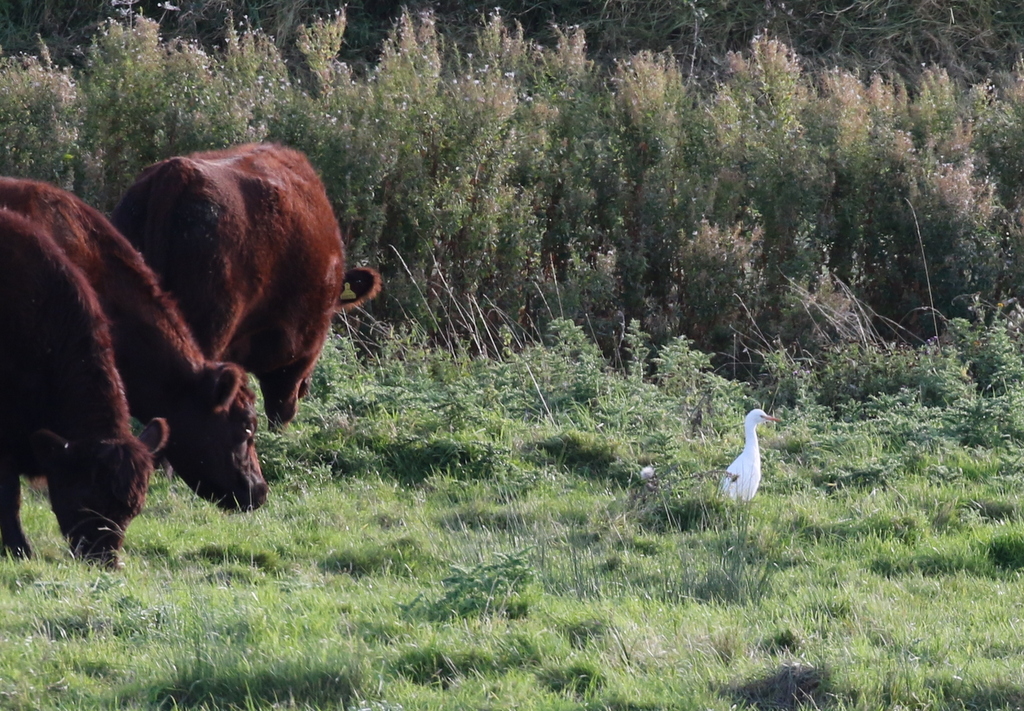Day 1 of a three day long weekend of tours today. It was a glorious sunny day, warming up through the morning so we were shedding layers after a cool couple of days, with light winds. A glorious day to be out on the coast.
After meeting in Wells, we made our way east to Cley. The car park at the bottom of the East Bank was surprisingly busy, but we managed to park at Walsey Hills which was empty. As we walked back to the East Bank, we could hear tits calling in North Foreland wood, but there was too much traffic to catch them properly and we couldn’t see them.
There were lots geese out on the grazing marshes on Pope’s Marsh, mainly Greylags with smaller numbers of Canada Geese and a few Egyptian Geese in with them too. A few Teal were dabbling around the small pools in the grass. Further over, we could see more ducks, a selection of Wigeon, Teal, Mallard and Shoveler. We managed to pick out a rather distant Pintail on Pope’s Pool too.
There were fewer waders out here today, but still a number of Lapwing down in the grass and several Ruff around the Serpentine, mostly brown juveniles. A Common Snipe was preening in the grass along the far edge. A Greenshank flew in calling landed behind us on Snipe’s Marsh. We could hear a couple of Water Rails squealing out in the reeds the other side.
 Ruff – there were still several on Pope’s Marsh, mostly juveniles
Ruff – there were still several on Pope’s Marsh, mostly juveniles
A raptor circling over the reeds as we looked across the reedbed turned out to be a Common Buzzard. They do drift over this way occasionally, but we wondered whether perhaps this was a sign that they were going to be on the move again today, taking advantage of the warmth in the air. So it would prove to be, as we saw a number circling up and heading west throughout the day. A Marsh Harrier was more predictably circling up over the reeds too.
Skylarks have been scarce recently, but we heard several calling overhead as we walked out. Perhaps it was the glorious sunny weather we were treated to this morning which has brought them out? A Reed Bunting perched up nicely in the top of the reeds. A Reed Warbler was slightly less obliging, feeding low along the edge of the ditch by the reedbed until we turned to look at it, at which point it disappeared back into the reeds, before flying off.
We heard Bearded Tits several times as we walked out along the bank, but they were hard to see at first. One perched up briefly out in the middle, but just before flying off and disappearing back down into the reeds further back. It was not until we got to the main drain that a noisy flock of six Bearded Tits flew in and landed in the reeds in front of us, climbing up into the tops for a few seconds before dropping back down again.
 Bearded Tits – circling up, thinking about setting off
Bearded Tits – circling up, thinking about setting off
The Bearded Tits have been very active and vocal in the last few days here. This is the time of year when they disperse and they are getting itchy feet. Sure enough the six Bearded Tits took off and flew round, starting to circle up higher into the sky. It looked like they might be off, but a minute or so later, after we had lost sight of them, they dropped back steeply into the reeds where they had just left.
There have been Otters on and off in the main drain at Cley for some weeks now. A quick scan down the channel and we spotted a head sticking out of the weed which is now carpeting the water. A second head surfaced nearby. The two Otters started to swim towards us, ducking under the weed, looking for food. We could see the little patches of reed along the edge of the channel shaking as they swam through them. They were busy looking for food as they approached the sluice right below us, it was great to watch the heads pop out of the weed and then their long bodies and tails curve into the water as they dived. It was hard to tell how many there were now, at one point some of the group thought a third Otter had joined them.
 Otter – eating a crab in the main drain right by the sluice
Otter – eating a crab in the main drain right by the sluice
We weren’t sure what the Otters would do at the sluice, whether they might come up out of the water, but they ended up swimming straight through. We could see the reeds rustling the other side and then a head popped up out of the weed again. This time it had caught something and we watched it holding it in its front paws and crunching on it. It looked rather like a crab and looking at photos later confirmed this. While the first Otter swam with its crab across the channel and into the reeds the other side, we could hear the second crunching on something just below us, out of sight in the reeds by the sluice.
Once it had finished its crab, the first Otter swam back across the channel into the reeds the other side. We could hear the two of them calling, but they didn’t come back out again for a few minutes. It had been great to watch them fishing, but we decided to move on.
As we walked down the East Bank earlier, we had been told that a Red-necked Phalarope had been seen on Sea Pool this morning. We were looking into the light at Arnold’s Marsh from here, so we decided to head straight along to Sea Pool instead. It didn’t take long to find the Red-necked Phalarope, exactly where it had been earlier, along the edge of the reeds on the far side, but we had to walk some way further along so we were not looking straight into the sun.
 Red-necked Phalarope – a ‘record shot’ of the juvenile this morning
Red-necked Phalarope – a ‘record shot’ of the juvenile this morning
Given the sun, there was quite a bit of heat haze from the expanse of shingle in front and it was always rather distant, but we had a good look at the Red-necked Phalarope as it swam in and out of the reeds. We could see its black mask, golden-straw striped dark back and needle like bill.
While we were standing admiring the Red-necked Phalarope, we also kept looking out over the sea the other side. There were small numbers of geese and ducks moving offshore, Brent Geese and Wigeon coming in from Russia for the winter, little flocks of Teal and a more distant line of Common Scoter.
A couple of very distant Gannets flew past, right out in front of the windfarm. Three Sandwich Terns were still fishing offshore. A Red-throated Diver helpfully flew closer in and we could get it in the scope. One of the group picked up a bird flapping across the surface of the water and it turned out to be a Guillemot being chased by a Grey Seal. The Grey Seal gave up and the Guillemot swam off in the other direction.
A couple of Marsh Harriers circled up from Pope’s reedbed. Beyond, over the hillside behind, we noticed three more Common Buzzards circling up on a thermal. They really were on the move this morning.
Walking back, it was better light to look at Arnold’s Marsh from this side. There were lots of Black-tailed Godwits here, along with several Redshank and Curlew. We could see a small group of Dunlin preening or dozing in the saltmarsh on the near side, and as we walked back towards them, two Dunlin were feeding in the edge of the water. A smaller wader walked out next to them, a Little Stint,but unfortunately it promptly took off and we watched it fly away west, over the East Bank.
On our way back along the bank, a Kingfisher flew off over the reeds but was too quick for most of the group to get onto. As we walked towards the car, we could see a Grey Heron standing on the edge of the reeds on Snipe’s Marsh and a couple of Little Grebes were busy diving the other side.
It was already midday by the time we got back to the car, so it was decided to have an early lunch and use the facilities back at the visitor centre. It was lovely sitting out in the sunshine today. We looked up at one point to see three more Common Buzzards circling overhead.
 Common Buzzard – one of several moving today
Common Buzzard – one of several moving today
After lunch, we drove round to the beach car park and set off to walk out to North Scrape. The cows were all feeding on the north side of Eye Field and in between them we noticed a small group of Golden Plover, which we stopped to look at in the scope. There were lots of Starlings feeding down in the grass too.
As we walked across the shingle, several Meadow Pipits came up from the vegetation and a little flock of Linnets flew up from the weeds. A couple of Pied Wagtails were feeding around the muddy edge of the pool. There were several Wheatear here a week or so back, but they had all moved off ahead of the recent cool weather. We were just saying how it the sort of day when more Wheatear could appear when one landed on the post right in front of us.
 Wheatear – landed on a post right in front of us
Wheatear – landed on a post right in front of us
The Wheatear stayed on the post for about a minute, looking at us nervously, while we watched it through binoculars. Then it flew off across the shingle, flashing its white rump. We could still see it further over, hopping about on the stone in amongst the vegetation.
North Scrape has been rather full of water in recent weeks and consequently somewhat devoid of waders. After recent management work on the reserve, it has gone from one extreme to the other and is now a large expanse of mud. It is looking really good for waders now, and no surprise that most of the waders have moved in here from the other scrapes.
 North Scrape – lots of exposed mud after recent management work
North Scrape – lots of exposed mud after recent management work
The light can be difficult on North Scrape, looking into the sun, and the birds can be distant, but we quickly located two juvenile Curlew Sandpipers down the left side. They were with a couple of Ruff and through the scope we could see their long, downcurved bills and peachy-orange wash across the breast.
Across the other side, a Ringed Plover walked out from behind the reeds, quickly followed by a Little Stint. It was tiny in comparison! More birds followed, and we had counted five Little Stints and six Ringed Plover before they were spooked by something and flew round. There were plenty of Dunlin on here too, and when everything landed again they were even more distant. Still, as they started to feed and spread out, we could make out at least ten Little Stints in with them. A Greenshank was slightly easier to see, when it walked out from behind the reeds, much closer, with a Redshank nearby for comparison.
On the walk back to the car, a Wheatear was on the fence across the other side of the shingle from the path, on the edge of the Eye Field. It was quickly joined by a second Wheatear which flew up from the grass – they had multiplied in the short time we had been out at North Scrape! A little further on, what was possibly a third Wheatear flew across the shingle to where they had been a few moments earlier.
Our destination for the second half of the afternoon was Kelling. As we started walking down the lane, we could hear Chiffchaffs calling from the hedge. A couple of Greenfinches were lurking in the top of the blackthorn but finally hopped out and showed themselves. A Chaffinch flew in to join them.
Out in the stubble field, we could see lots of Red-legged Partridges. They have been released here in big numbers for shooting. We flushed a Pheasant from beside the path too. As we got to the copse, we could hear Long-tailed Tits calling. We looked up into the trees to see them feeding there. It was a mixed tit flock – as well as the Long-tailed Tits, there were Blue Tits and Great Tits, and at least one Chiffchaff too. Unfortunately there was nothing rarer with them today!
 Long-tailed Tit – we came across a mixed tit flock in the lane
Long-tailed Tit – we came across a mixed tit flock in the lane
A Hornet was buzzing backwards and forwards low around the bushes and ivy on the edge of the copse, it seemed to be looking for food. Suddenly it seemed to spot a spider in the middle of its web and it went for it, diving into the web. The spider dropped off its web onto the nettles below, while the Hornet struggled to free itself from the strands of silk at first. Once it was free, the Hornet buzzed around the nettles to see if it could find it, but the spider had sensibly disappeared into cover.
A Lesser Whitethroat in the hedge along the lane just north of the copse unfortunately did not hang around long enough for everyone to see it, disappearing into the bushes as a couple of people walked past from the other direction.
It is hard to see the Water Meadow over the brambles at first now, as you walk up along the lane. We could see a few Ruff and a Redshank or two around the edge of the water. Two Lesser Black-backed Gulls had dropped in to bathe. It was only when we got almost to the cross track, and looked back, that we spotted the Curlew Sandpiper. It was feeding in the shallow water on the near edge, wading up to its belly. Two Dunlin were on the mud nearby. Through the scope, we got a much better view of this Curlew Sandpiper than we had of the two on North Scrape earlier.
 Curlew Sandpiper – this juvenile showed much better on the Water Meadow
Curlew Sandpiper – this juvenile showed much better on the Water Meadow
After watching the Curlew Sandpiper for a few minutes, we carried on down towards the beach. The Quag looked rather quiet, so we turned right and started to make our way up the hill before the beach. We flushed a couple of Meadow Pipits from the rough grass as we passed. Three Stonechats flew across the path in front of us and landed out on some tall stems in the middle of teh grass. A Linnet flew in to join them.
We had another quick look out to sea. A couple more Gannets flew past offshore, closer in than the ones we had seen earlier, which meant everyone could get onto them this time. Another line of distant Common Scoter flew past too, but it didn’t seem as lively as it had been earlier this morning.
It was time to start heading back now, so we walked back to the car and set off back towards Wells. There was still time for one last surprise though. We had looked for the Cattle Egret in the field east of Stiffkey on our way out earlier this morning, but it hadn’t been with the cows. Pulling up on the road on the way back, we spotted the Cattle Egret immediately, out with the cows. Thankfully, there were no cars coming along the road and we were able to pull up and spend a couple of minutes looking at it. That was a nice way to end the day.
 Cattle Egret – a good way to round off the day, back with the cows
Cattle Egret – a good way to round off the day, back with the cows
















